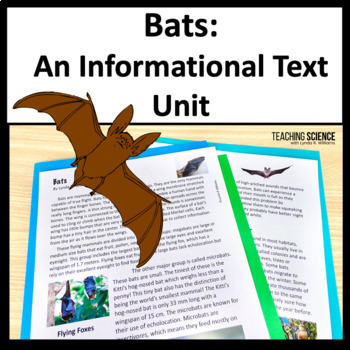All About Bats
All About Bats is an Informational Text Reading Unit on Bats.
Students will love learning all about bats! Bats have adaptations that help them to survive! This is high-interest nonfiction, a six-page reading passage with comprehension questions. Students will learn all about bats, their adaptations, their contribution to the ecosystem, their behavior, their lifecycle, and more. After reading in a CLOSE Reading format, students will answer text-dependent comprehension questions and fill out interactive notebook folds that help them really think about the reading. A true/false sorting activity is included which can be used for fast finishers or as a literacy center. (It is also self-checking) Bats are really interesting animals.
This Bats Reading Comprehension passage is great for scientific reading, practicing reading informational text, conservation, and environmental reading and would also be great for Halloween. This is a scientific reading so some of the myths about bats will be dispelled. Students will enjoy this high-interest reading that is all about bats.
Students will learn that there are different types of bats and they have a variety of adaptations, feed on different types of foods, and care for their young. Students will love learning about bats.
Great for Halloween Reading or Scientific Reading.
Your upper elementary students will love learning about bats!
This Bats Reading unit will take about a week to complete if you follow the close reading guide and if you choose to use all of the response pages. Answer keys are included. Great for grades 3-6.
While this unit does not completely cover the NGSS standards, It touches on and addresses concepts in the following standards:
NGSS 3-LS2-1. Construct an argument that some animals form groups that help members survive
NGSS 3-LS1-1. Develop models to describe that organisms have unique and diverse life cycles but all have in common birth, growth, reproduction, and death.
NGSS 3-LS4-2. Use evidence to construct an explanation for how the variations in characteristics among individuals of the same species may provide advantages in surviving, finding mates, and reproducing
NGSS 4-LS1-1. Construct an argument that plants and animals have internal and external structures that function to support survival, growth, behavior, and reproduction.
NGSS 4-LS1-2. Use a model to describe that animals receive different types of information through their senses, process the information in their brain, and respond to the information in different ways.
This resource is also aligned with the science standards for Utah's third grade.
Utah SEEd 3.2.1 Develop models to describe patterns of change that organisms go through during their life cycles. Emphasize that organisms have unique and diverse life cycles, but all have in common birth, growth, reproduction, and death.
This resource is also aligned with the science standards for Utah third grade SEEd 3.2.1.
Other teachers LOVE this unit. Check out two of the 100+ perfect reviews:
-Pretty C.
-Shelob L.









